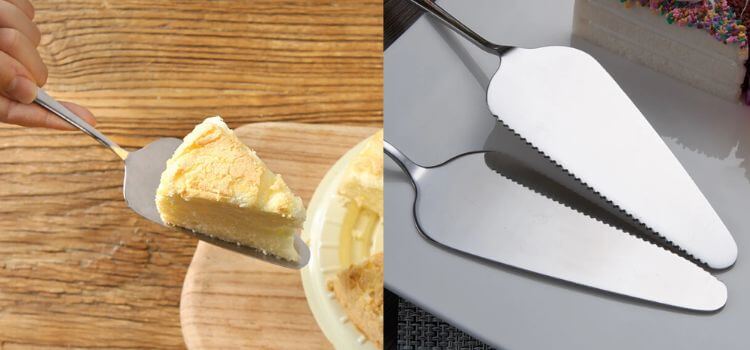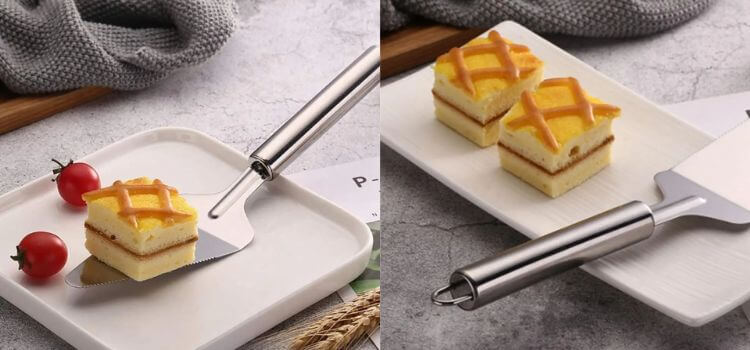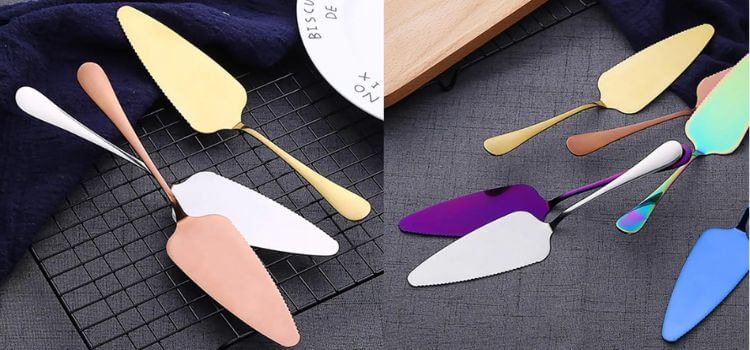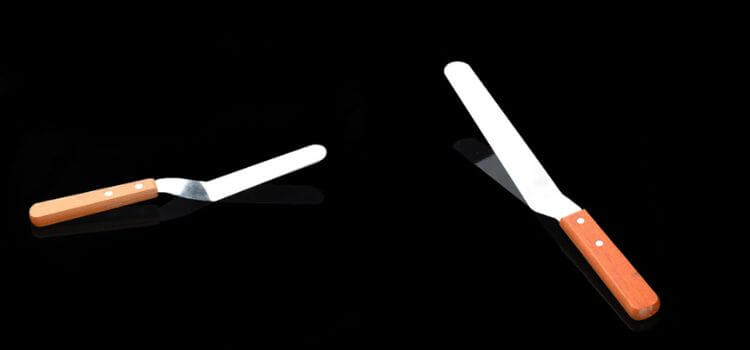As an Amazon Associate, I earn from qualifying purchases

In baking and serving delectable treats, the debate between a pie server and a cake server is crucial. These utensils may seem similar at first glance, but each has unique strengths that can significantly impact how your desserts are presented and enjoyed. I
In this article, we break down the differences between pie servers and cake servers, offering insights into their design, functionality, and which one is best suited for various dessert types.
Whether you’re a baking enthusiast or a dessert connoisseur, understanding the nuances between these two tools is essential for serving up sweet delights with precision and style.
Understanding Pie Servers

Pie servers are specialized utensils designed explicitly for cutting and serving pies. They typically have a triangular, pointed shape with serrated edges that make it easy to cut through flaky crusts without breaking them apart. The sharp tip of the pie server allows for precise cuts, ensuring each slice is evenly sized and beautifully presented on the serving plate.
Design and functionality
Pie servers are made from various materials, including stainless steel, plastic, and wood. However, the most common material is stainless steel, which offers durability and ease of cleaning. Some pie servers also come with a serrated edge on one side for cutting through pies with crusts that tend to be more delicate.
In addition to their functional design, many pie servers also have elegant and decorative handles, making them a beautiful addition to any dessert spread. They can vary from minimalist designs to intricate patterns, each adding a touch of sophistication to the serving experience.
How to use a pie server effectively
To use a pie server, start by cutting through the pie’s crust with the sharp edge of the utensil. Then, gently slide it underneath the slice and lift it onto a plate. It’s essential to hold the pie server horizontally to prevent any filling from spilling out.
Key Features of Pie Servers
- Triangular, pointed shape
- Serrated edges for cutting through crusts
- Sharp tip for precise cuts
- Made from various materials, including stainless steel and plastic
- It may have decorative handles.
Pros and Cons of Pie Servers
While pie servers excel at cutting and serving pies, they may not be the best choice for other types of desserts. Here are some pros and cons to consider when using a pie server:
Pros:
- Precise cuts for even slices
- Sharp edges for easy cutting through crusts
- Elegant design adds to the presentation.
Cons:
- Limited functionality for non-pie desserts
- Some designs may be too delicate for cutting through thicker crusts.
Understanding Cake Servers

Cake servers, on the other hand, are versatile tools that can be used for various desserts. They have a flat, triangular shape with a wide edge and serrated edges on both sides. This design allows easy slicing and serving of cakes, tarts, and other baked goods.
Design and functionality
Like pie servers, cake servers are made from various materials, including stainless steel and plastic. However, their wider shape makes them suitable for larger desserts like layer cakes or sheet cakes. The serrated edges on both sides make cutting through soft and delicate cakes easy without ruining the presentation.
Many cake servers feature a flat, wide handle that offers a comfortable grip, making it easier to cut through thick cakes. This feature is especially helpful when serving denser desserts like cheesecake or brownies.
How to use a cake server effectively
To use a cake server, cut through the dessert’s edges with the serrated edges on both sides of the utensil. Then, slide the server underneath the slice and lift it onto a plate. The wider edge of the cake server makes it easier to support larger slices without them falling apart.
Key Features of Cake Servers
- Flat, triangular shape
- Serrated edges on both sides
- Wide handle for a comfortable grip
- Made from various materials, including stainless steel and plastic
Pros and Cons of Cake Servers
While cake servers are versatile and can be used for a wide range of desserts, they may not provide the same precision as pie servers when cutting pies. Here are some pros and cons to consider when using a cake server:
Pros:
- Versatile for various dessert types
- Serrated edges on both sides make cutting easy.
- Wide handle for comfortable grip
Cons:
- May not provide precise cuts for pies
- Limited to serving desserts with flat or soft textures
A Comparison: Pie Server vs Cake Server
Now that we’ve explored pie and cake servers’ design, functionality, and key features, let’s compare the two utensils side by side.
Pie Server | Cake Server |
Triangular, pointed shape | Flat, triangular shape |
Serrated edges for cutting through crusts | Serrated edges on both sides |
Sharp tip for precise cuts | Wide handle for comfortable grip |
Made from stainless steel and plastic | Made from stainless steel and plastic |
Elegant design adds to presentation | Versatile for various dessert types |
As seen in the table, pie and cake servers have similar materials and overall design characteristics. However, their shapes and specific features make them better suited for different types of desserts.
Making the Right Choice For You

When choosing between a pie server and a cake server, there are a few factors to consider, including:
- Type of dessert: A pie server may be the better choice if you primarily eat pies or other desserts with delicate crusts. On the other hand, if you enjoy various types of desserts like cakes and tarts, a cake server would be more versatile.
- Presentation: If you want to add an elegant touch to your dessert presentation, a pie server with a decorative handle may be better. However, if you prefer a more functional and straightforward design, a cake server would suit your needs.
- Comfort and grip: If you have difficulty holding utensils or need extra support when cutting through thicker desserts, a cake server’s wider handle may be more comfortable for you.
Tips for enhancing dessert presentation with the appropriate utensils:
- Consider the shape and texture of your dessert when choosing between a pie server and a cake server. For example, if you have a tall layer cake, a cake server’s wider shape may provide more stability when serving.
- Match the utensil to your overall table setting or theme. A decorative pie server with an intricate handle can elevate the presentation of your desserts.
- Don’t be afraid to have both utensils on hand for different types of desserts. While one may excel at serving pies, the other may work better for cakes or tarts.
Conclusion
In conclusion, pie and cake servers are essential for serving desserts. Each offers distinct features and benefits, making them perfect for various types of desserts. By comprehending their design, functionality, and advantages and disadvantages, you can make an informed choice tailored to your specific needs, thereby elevating your dessert presentation.
So whether you’re enjoying a slice of apple pie or a decadent chocolate cake, having the right utensil on hand can make all the difference. So indulge in your favorite desserts with the perfect server by your side. Happy serving!
As an Amazon Associate, I earn from qualifying purchases